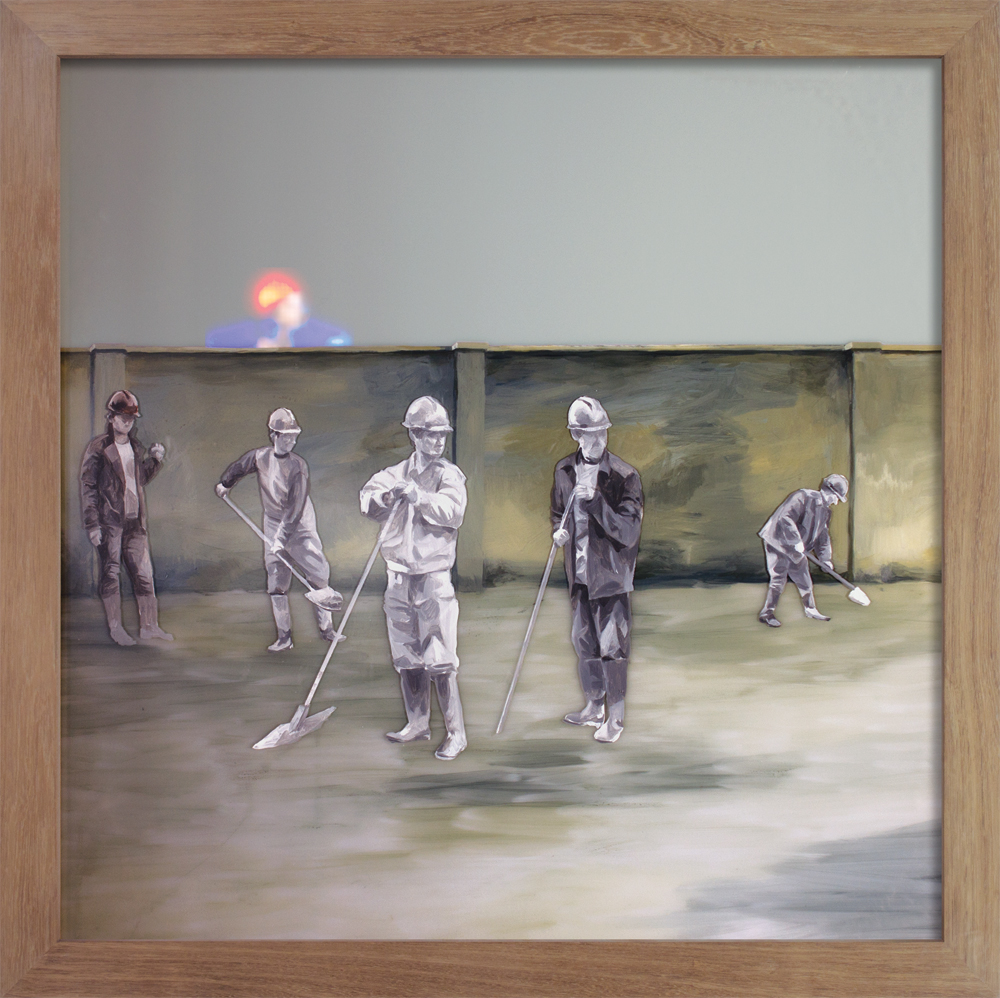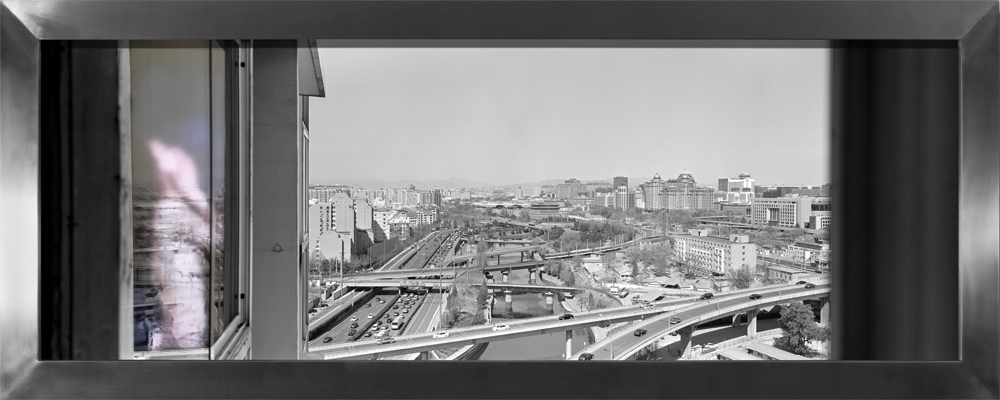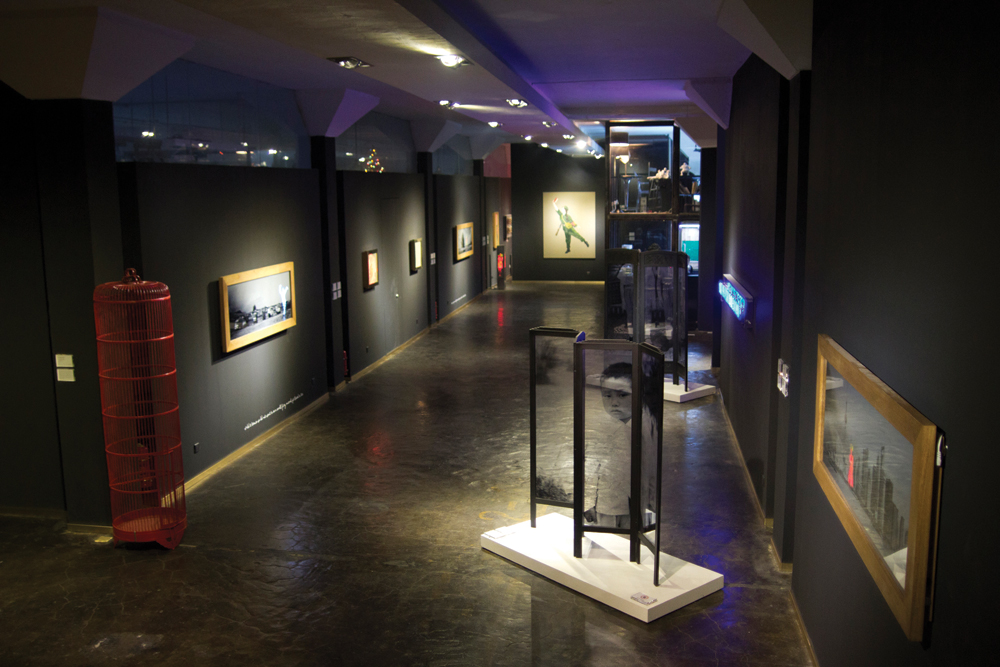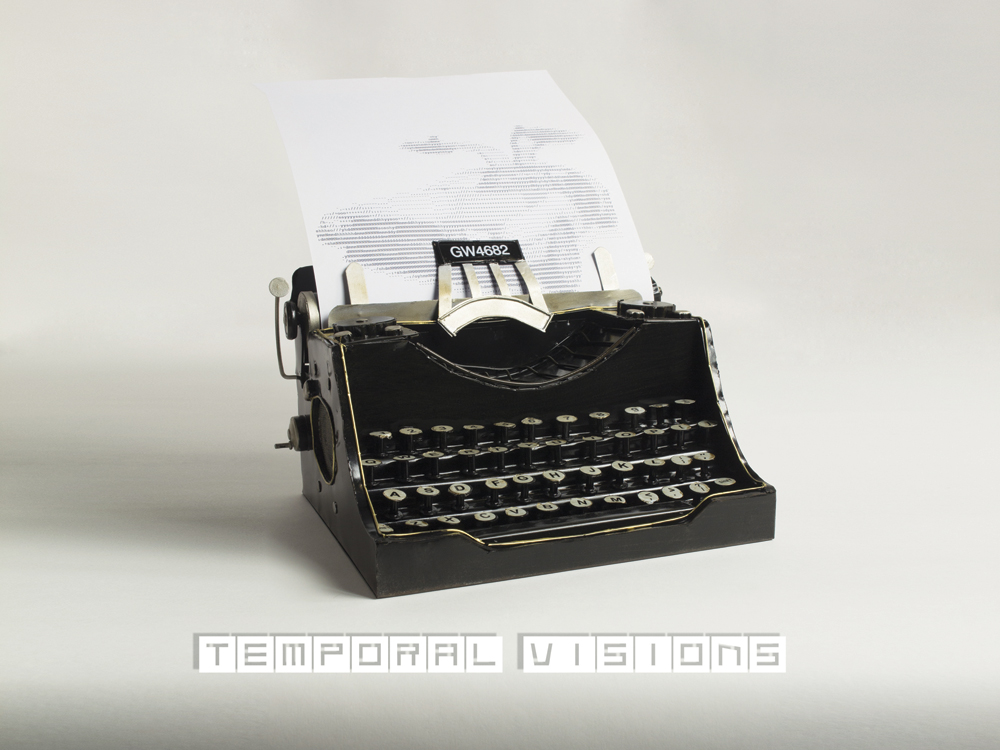« Features
Diversity and Collaboration: An Interview with The island6 Art Collective of Shanghai
The island6 Art Center is a non-profit studio and gallery space located in Shanghai’s M50 art district, an abandoned industrial space on the Suzhou Creek that now includes more than 100 studios and galleries. Referring to themselves as Liu Dao (a Pinyin phrase meaning “island number 6″), the artists of the island6 collective includes painters, sculptors, photographers, filmmakers, digital imaging artists, dancers, performers, writers, engineers and curators. Liu Dao regularly produces themed exhibitions in collaboration with guest curators.
Since 2009, island6 has exhibited only works made on site by the Liu Dao collective, which is made up of Chinese and international artists. Group discussion and collaborative effort is central to Liu Dao’s method, explains Thomas Charvériat, founder and director of island6: “One of the current aims of island6 is to make art using the same process as the film industry, giving due credit to all those involved whose varied skills and backgrounds enrich the artwork.” Reflecting the film- making process, each project includes a cast and crew listed in the form of credits.
Liu Dao was formed in response to the booming Chinese art market, which Charvériat observes, “was creating misplaced priorities and selfish ambitions in many young and susceptible artists.” The members of Liu Dao believe that success does not come simply from individual talent. Rather, dialogue and collaborative effort is the best method for creating and experiencing art.
This interview took place at the island6 Art Center last August. I spoke with two island6 curators: Cecilia García (she is half Sri Lankan, half Filipina, and trained as an actor at the London School of Dramatic Art) and Margaret Johnson (born in Athens, Ga., she studied photography at the Pratt Institute of Art in Brooklyn and has degrees in art history and psychology from the University of Georgia).
By Andrew Nedd
Andrew Nedd - Talk about the significance of the collective nature of the group’s work. How is this reflected in your process?
Cecilia García - To begin with how we work, the initial idea for any project starts with coming up with an idea for a themed exhibition, so we will have a team of writers and the artistic director come together and propose ideas for a project. The concept is often shaped by who is currently available. For example, two of our recent shows, “Metropolis Rises” and “Modus Operandi,” included the contributions of a resident painter from London who specializes in oil painting. Another resident artist dealt with the paper collages. Then we have a permanent technical team that operates vinyl cutters, laser engravers, projectors and other machines. And for postproduction we currently have a French filmmaker who does all the programming and editing. The results are works of art that are truly multilayered.
Margaret Johnson - In terms of the diversity of the nationalities and backgrounds of our group, this reflects the reality of living in Shanghai, a city that has a complicated history and is made up of many nationalities.
A.N. - What kind of work is the product of the teamwork and cultural exchange you just described? Please address what the viewer encounters and what you intended for the viewer to experience.
M.J. - Much of the work is a conversation between contemporary technological art forms, such as LED panels, and traditional motifs or techniques like paper cutting and painting. Visiting our gallery you may encounter paper-cut images of bamboo trees or cherry blossoms on a rice paper canvas, and these could be matched with LED birds and butterflies. Bamboo is associated with traditional China, but it is also a symbol of strength that supports China as it moves into the 21st century. A number of pieces, like 7 Candies Is Equivalent To One Glass Of Milk, draw upon the imagery of communist China and merge this with the allure of advertising and popular culture, which is another example of the interaction of past and present that characterizes our work.
A number of our works require ambulation, even direct touch in order to activate them. Others require the viewers to get out their mobile phones and place a call in order to close the circuit, so to speak. One of my favorite things about our artwork and our gallery space is how people react to moving images. People frenetically wave their arms back and forth trying to determine if the LED panels react to their movements, and my personal favorite question to hear is, “What is this?” These encounters force viewers to become aware of their own bodies, their corporality, and of the process of perception.
Another thing that I believe catches people off guard is that our artwork is not necessarily constrained by its frame; the animations are not locked in and are free to travel past their teakwood or stainless steel homes. Most other artworks have a border and the images stay within a fixed area. At island6 we’ve look past the frame, we don’t believe the work has to be constrained.
Our artworks, other than concept and creation, are rather easy to deal with when they are completed. Installation is as simple as plugging it in and since LED is a very stable medium, the works have a very long life. Most of our works go to private collectors but many have been sold to hotels, and brands such as Louis Vuitton sometimes commission them as well.
A.N. - I first visited island6 last summer and I was really struck by the innovative way studio, design and exhibition areas are arranged. As we sit here in this office I can view many of your colleagues through the clear plastic floor below and through the walls, too. How does the spatial arrangement aid your work?
M. J. - It is very important to us to have a good flow and separation of space. We can peer out from our glass-walled command center-as we call the structure we are sitting in now-and see the person we were trying to find, as you noticed earlier; and you can still hear the industrial chatter coming from within the workshop. But I suppose, the longer you live in Shanghai, the more the sounds of drills and saws become a part of your urban soundscape and they generally, in time, fade away.
Another thing about the layout of our space is what this means for the visitor who has wandered into the gallery. Seeing a rather ostentatious glass and steel, two-level cube sitting in the center of a rather large gallery can be quite striking and is often photographed just as much as our artworks themselves. We also always have our workshop open to visitors, and as I mentioned, all of our artwork is made on site. So, upon wandering inside the studio, one could quite possibly see the next island6 project being put together and prepared.
A.N. - island6’s artistic and exhibition practices appear to go against the grain of recent artistic currents in China. How does the group perceive its place in the current art market here?
C.G. - We hope that all of our works of art present some sort of challenge to the current art market. China is a relatively new art market and people are buying art not because they like it, but principally for investment. The Chinese viewing public often doesn’t know what to make of our anonymous, new media projects. What’s great about our art is that it is so easy and accessible to the public and to collectors. I think a lot of collectors appreciate the fact that with many of our pieces it is just a case of plugging it in and turning it on and that does the trick. In addition, we create a lot of work for corporations and, in terms of commercial settings, many of our pieces are displayed in hotels and restaurants.

Liu Dao, 7 Candies is Equivalent To One Glass Of Milk, 2013, RGB LED display, one-way glass, teakwood frame, 16” x 16” x 2.”
M.J. - Commercial ventures are really interesting platforms that can make works of art accessible to a large number of viewers in a public setting. One example is the new K11 Art Mall, which opened this summer. We have a number of works on view there and they appear on the walls all over, even in the elevators. K11 was conceived as a multi-use space that combined living and commercial functions with the exhibition of works of art. The lowest level is a dedicated exhibition and education area, and aboveground levels combine fashion and design shops with what they call “art corridors.” In one work that is on view there, A Day in the Life of Xiao Gu Niang, the viewer can call the number on the screen and watch as the shopping girl struggles to find her phone among all her new purchases. Later she sends a text message response to the caller, something along the lines of “Sorry, got more important things to do.”
We have recently been working again with LVMH and Louis Vuitton on some collaborative projects, so that’s always an interesting thing as the convergence of art and fashion has been really growing, especially in China.
A.N. - In interviews and essays, Thomas Charvériat often employs cinematic language when addressing the work: cast, credits, narrative, etc. Was this the concept from the beginning?
M.J. - Well, this is just the nature of new media artwork in general. We have so many skill sets we need to draw upon from for each project, which means that there is no way really that only one person can do it all. We have a very diverse team that is made up of individuals with many educational and cultural backgrounds, skills and languages. It is impossible not to think in terms of cast. You have someone producing animation, filming the performance, someone else working with video and employing editing software. Then there are set builders, actors and choreographers. The method is very film-based. Thomas often speaks of bringing the cinematic experience to a broader level with the art center acting as producer and the artists serving as actors or cast and crew, and the writing team plays the role of director.

Liu Dao, When The Dust Settles, 2013, RGB LED display, acrylic painting on plexiglass, teakwood frame. Exhibited in “Metropolis Rises.”
A.N. - Some of your works are set to loop but others are much more interactive. How do you deal with these different experiences of time?
M.J. - New media art is time-based, so it is very connected to the cinematic experience, especially many of our animations, which are set to loop and are thought of as cycles, but they can have a narrative structure, too. But, as you point out, other works are interactive. Our next show, “Temporal Visions,”3 deals with a variety of notions of time, including cyclical time, which is expressed in animation loops. It also draws on Taoist philosophies, the contrast of our modern notion of time, which is very linear, and Taoism which is more circular. As a Shanghai-based collective, or goal was to explore what these two notions of time mean for the ever changing nature of this city.
A.N. - Your recent works deal with the urban experience in Beijing, Shanghai and Hong Kong. China, as everyone knows, is currently undergoing massive urban expansion and rural migration. What are your perceptions of the perils and possibilities of these tremendous demographic changes?
C.G. - As a Shanghai-based art collective we aim at being reflective of our surroundings. And in Shanghai at the moment there is a tremendous amount of development going on. At the same time, we are aware of the city’s complicated history. Above all, I’d like to think that the viewer is surprised by our work. When I came to China it was a surprising, really overwhelming experience. Our work, I feel, provides a surprising view of contemporary China.
M. J. - We take a lot of inspiration from these demographic changes, but we want the viewers to come to their own conclusions. We make observations and we want to start a conversation about life in contemporary China. “Body-City-Mechanism” was held in Shanghai and that show takes a more idealistic approach to expansion. The works in that show were inspired by the idea that cities are like living organisms. Cities grow, change and sometime die. “Metropolis Rises,” which just closed in Red Gate Gallery (Beijing), had a darker hue as it explored the dangers of technology. Jean Baudrillard and Isaac Asimov informed the dark cityscape we evoked with that show. “Modus Operandi” drew on the office work, which we see as the essential 21st century experience. The exhibition took place in the offices of the Hong Kong architectural firm 10 Design. These exhibitions are programmatic, but as I said before they are intended to open conversations. We don’t aim to make a decisive statement with these exhibitions.

Liu Dao, Rear Window, 2013, RGB LED display, Giclée print face-mounted on plexiglass, stainless steel frame, 79” x 31.5” x 3.5.” Exhibited in “Metropolis Rises.”
A.N. - I enjoy reading the statements that accompany your individual pieces. Many of them read as narratives, using a voice that either speaks directly to the reader (‘you’) or that describes the experiences of a character (‘he/she/him’). What do you want viewers to take away with them when they read your texts?
C. G. - Many of them do have a sense of mystery. Above all, we don’t want to tell the viewer what to think, how to think, just to make them think. Thomas is very clear that he intends for our writing style to not to tell the viewer what to think. He doesn’t want us to explain why specific material is used; he just wants us to open a dialogue.
M. J. - With most of them we like to weave in one or two cultural artistic movements. Rear Window, which was part of our recent “Metropolis Rises” exhibition, for example, is an obvious Hitchcock reference, which ties into the history of cinema. Cecilia wrote the text for this work and it reads from the point of view of a young man who spies on a girl in a neighboring apartment. I write these kinds of texts, too, and sometimes I find it difficult since as an art historian I was trained to write a certain way. I am told to “be more casual” and that I don’t have to explain everything for the reader.
C. G. - Yes, for instance Beijing recently experienced a financial crisis and a lot of people lost their jobs. Also, many people live in close proximity in this country, so yes we do attempt to address life in contemporary China in a work like Rear Window. But it is also relates to many people’s lives. For instance, I come from London and I know what it is like to live in a city where many people have lost their jobs and they live in tight quarters. When I write the texts I try to address life in China but I also draw on my own experiences.
NOTES
1. Charvériat, Thomas, Preface to island6 Catalog 2011. North Stainmore: Fold Press, 2011, 4.
2. Charvériat, 4.
3. “Temporal Visions” took place from September 5th to October 17th, 2013.
Andrew Nedd teaches art history at the Savannah College of Art Design, where he is chair of its biennial art history symposium. Nedd has published several anthology essays and book reviews and co-curated the exhibition “Builders, Bolsheviks, and Bulldozers: Facets of 20th-Century Russian Art.” He is currently co-editing Killing Images, an anthology that deals with censorship of the image.





































Leave a Reply
You must be logged in to post a comment.